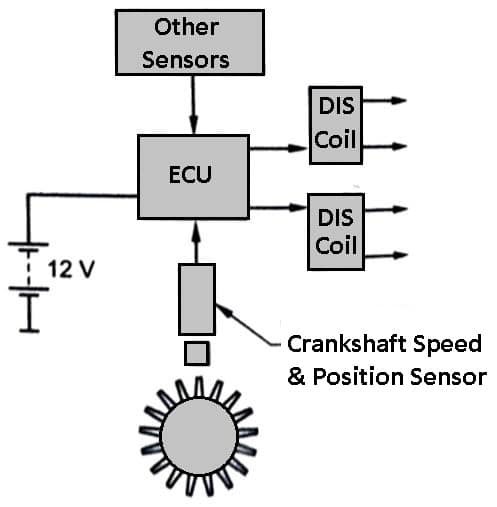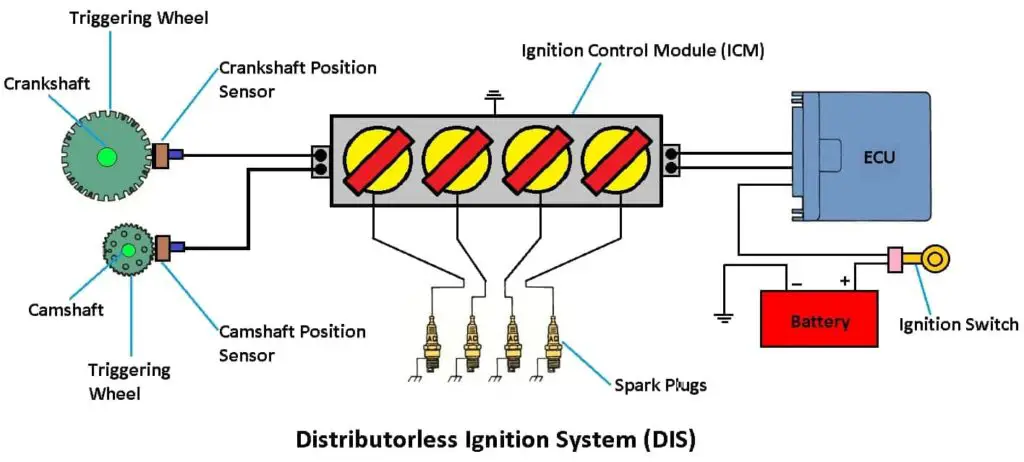In this article, you will learn how does a distributorless ignition system work? And its diagram, components, applications, advantages, and more.
If you want the PDF? You can download it below the article.
What is Distributorless Ignition System (DIS)?
A distributorless ignition system is a type of ignition system, that is consists of multiple induction coils instead of having a distributor of an electronic ignition system.
This is very different from the traditional and electronic ignition systems. The coils rest on top of the spark plugs. In addition, there are no spark plug wires in the system, and it is electronic.
In this system, the spark plug is fired from the coil and the timing of the spark plug is controlled by an Ignition Control Unit (ICU) and Engine Control Unit (ECU), making the system more efficient and reliable.
Distributorless ignition systems normally consist of one coil per cylinder or one coil for each pair of cylinders. By using multiple ignition coils, each spark plug in these cylinders will ignite at the same time. These types of systems are also known as Direct Ignition Systems (DIS).
Components of Distributorless Ignition System
Distributorless ignition system consists of three main components, are as follows:
- Electronic control Module
- A crankshaft position sensor, and
- Distributoress ignition coil

1. Electronic Control Module
Several types of systems use a manifold absolute pressure sensor that is integrated into the module. The module works in almost the same way as the electronic Spark Advance system.
2. Crankshaft Position Sensor
The crankshaft position sensor is a reluctance sensor located on a reluctance wheel in front of the flywheel or just behind the front crankshaft pulley. The tooth pattern uses 36–1 teeth, which are spaced 10 degrees apart for the 36th tooth.
The missing tooth is found at 90 degrees for the number 1 and 4 cylinders before TDC. This reference position is located a certain number of degrees before TDC to determine the timing or ignition point as a fixed angle after the reference mark.
3. Distributorless Ignition Coil
The distributorless ignition coil consists of low tension winding that is supplied with battery voltage to a central terminal. Half of the winding is then connected to the earth in the module. The high tension windings are different and particular to cylinders 1 and 4, or 2 and 3.
Read Also: How does a Two-Stroke Engine works? Explained with Diagram [PDF].
Working of Distributorless Ignition System
The system is generally used only on four or six-cylinder engines because the control system becomes highly complex for a higher number of cylinders. Basically, It runs on the principle of the lost spark. The spark distribution is achieved through two double-ended coils, which are alternately fired by the ECU.

And the Ignition timing is achieved by crankshaft speed and position sensors, as well as load and other improvements. If one of the coils is fired, a spark is supplied to two cylinders of the engine, either it maybe 1 and 4, or 2 and 3.
The spark is delivered to the cylinder on the compression stroke which normally ignites the mixture. Whereas the spark in the second cylinder has no effect, as this cylinder is still completing its exhaust stroke.
Due to the low compression and exhaust gases in the lost spark cylinder, a voltage of 3 kV is needed for the spark to pass over the gap. This is similar to the cap voltage of the more conventional rotor arm. Therefore, the spark generated in the compression cylinder is not affected.
Advantages of Distributorless Ignition System
- By using a distributorless ignition system, it can eliminate wear on the moving parts of the distributor.
- They work through an engine computer that receives a top dead center signal from a sensor on the flywheel, so they can quickly adjust spark timing to suit a wider range of driving conditions.
- One of the most benefits is that they can easily adjust for the fuel that you are using. For example, if you use a low octane fuel, the computer can sense any detonation in the engine, and minimize the time it takes to deal with the low octane fuel.
- Because the RPM reference signal is raised directly from the crankshaft, it does not change as it wears out.
- This can eliminate the need to adjust the ignition timing from time to time.
- Distributor-less ignition systems are very reliable and require less maintenance cost.
- There is no distributor to drive, which gives less drag to the engines.
Disadvantages of Distributorless Ignition System
- A distributorless ignition system is more difficult to diagnose solid-state electronics.
- These types of ignition systems tend to be more expensive than conventional systems.
- It requires high voltage wiring from the coil to the spark plug as in the traditional system.
- The main drawback of a distributorless ignition system is its sensitivity to heat loss.
- Distributorless ignition systems are more dependent on sensors. Because, if one sensor goes off, the whole system will break.
Applications of Distributorless Ignition System
Following are some applications of distributorless ignition systems:
- Vehicles with 1.8 L, 2.8 L VR6, and 2.8 L V-6 engines are manufactured with this system and have been in use for over a century.
- Volkswagen Passat is the first car to be built with a distributorless ignition system and so far, the manufacturers are using it in the automobile sector.
- Furthermore, this distributorless ignition system is adopted by some high-end bicycles such as Ducati super sports.
Closing It Up
As I already said above, it is the system has a number of coils to spark the ignition by using the electronic module. Using this, each spark plug in the cylinder will ignite at the same time using a high voltage from a coil. The DIS is designed to generate high voltage.
So for now, I hope that you have learned about the Distributorless Ignition System. If you have any questions or doubts about this article, feel free to ask in the comments. If you found this article helpful, please share it with your friends.
Want free PDFs sitting at home? Then subscribe to our newsletter.
Download the PDF format of this article:
By reading this, you might want to explore more our blog:
nice
Thanks
Good
Thanks for reading.